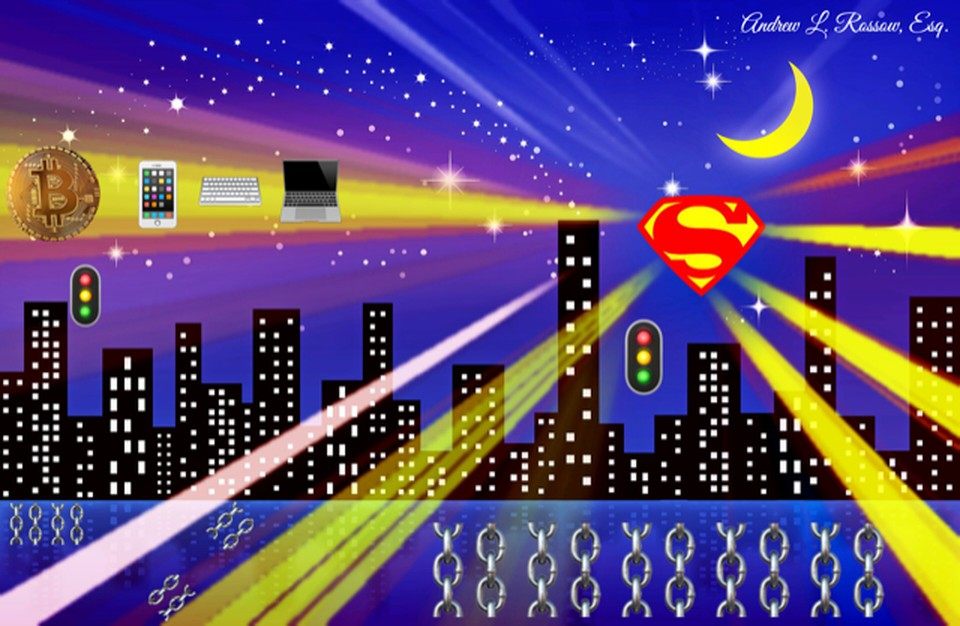
It's a bird! It's a plane! It's the Blockchain! It may not have the same ring to it as Superman, but sure enough, it aims to accomplish the digital equivalent. When Superman joined the Justice League, the chances evil forces or bad actors were able to seize the day, were minimal. The same can hold true with Blockchain technology as it relates to 21st century users.
The 21st Century Superhero
In this case, the Blockchain, is the superhero, and the companies and individuals it benefits, is the city of Metropolis. The Blockchain can seemingly accomplish the impossible by providing solutions to long-standing cyber-security and efficiency issues. Yet, its powers can be strengthened by combining it with other technologies and tools, such as artificial intelligence (A.I.) and bots.
So, what does integration look like for our 21st century infrastructure?
A Retail Powerhouse Platform
While a newer technology offers solutions that its predecessors did not, it still may not be able to address every issue. However, when combined with other technologies, the synergies tend to cover more of these problem areas. Strength is always in numbers, and I'm sure the Justice League would agree, if they were using Blockchain technology to help power the Hall of Justice.
Consumers can receive more transparent product information so they know exactly what they are buying. The range of information available, including, but not limited to its origin, characteristics, and history along the supply chain, help to maintain quality control.
While there are several projects out there devoted to automated supply-chain management and tracking, one company I came across, OSA DC, is an A.I.-driven, decentralized blockchain platform, enabling the collection of real-time data from retailers and consumers. The machine learning-enabled system takes all this data to quickly uncover patterns along the supply-chain, providing a personalized strategy for that segment. This helps to minimize any nuisances or poor behavior that would seek to diminish quality control.
Each member of the Justice League has his or her own ability or superpower that helps make them valuable to the team. Well, with the Blockchain, the power of smart contract technology binds transacting parties to their word, establishing trust on a much higher scale. From a legal perspective, this is game-changing in that parties cannot later claim they did not agree to certain terms and/or provisions of an executed agreement. With smart contract technology, you agree from the beginning, otherwise, the contract is never executed and/or runs autonomously.
Most importantly, with all of these parts in motion, the A.I. mechanism is able to collect consumer feedback, providing retailers with the information necessary to incorporate back into their business model.
The Evolution of 'SmarterChild' and Chatbots Galore
For those millennials reading this, you may remember 'SmarterChild' from your days on AOL or AIM. As a refresher, SmarterChild was a robot that lived in the buddy list of millions of AOL and AIM users, myself included. For many of us, it was our first interaction with artificial intelligence. SmarterChild allowed you to ask for movie times, weather updates, or answers to silly riddles you threw its way.
Even back in the early 2000's, chat bots were all the rage. AOL and AIM killed with this technology. It was the first time users were able to interact with someone or something that could give them immediate answers to questions they asked.
Now, here we are in the 21st century looking down its family tree to the newly evolved "chatbots," or bots. Functioning as simple A.I. systems that a user can interact with through a keyboard, the conversations are usually fairly straightforward, as mentioned above. But, they can also be designed with complexity, having the ability to troubleshoot an issue with your internet service.
In 2018, we are past the days of SmarterChild and AIM. Still, it's no surprise that text messaging is the number one mechanism for communication. According to a Twilio study back in January, 89 percent of consumers prefer using text messaging to connect with businesses.
So, why are we suddenly seeing the explosion of bots in a world of social media and A.I. technology? Consumers want to take communication a step further, wanting more than just to communicate one way with a business. Having the ability to not only receive information, but the ability to reply and/or engage in conversations with the business, makes chatbots even more appealing.
Users are tired of downloading separate mobile apps for everything they need . Users, including myself, want a simple 'one stop shop' for their weather, sports scores, and any other requests they may have.
"[Users] are thinking, I don't want to download yet another application, especially if it doesn't need to be an app," said Matthew Hartman, head of seed investment at Betaworks, the startup studio behind Giphy and Bit.ly.
Service, Marketing, and Customer Engagement
According to Chatbots Magazine, "chatbots that operate in various, immediate messaging exchange systems are a growing tendency, which don’t seem to show any signs of slowing down in the nearest future."
According to a study done by Facebook IQ, businesses and their clients utilize the Facebook Messenger platform to exchange over a billion messages per month.
The research goes on to show that by the end of 2018, 78% of the world's smartphone users will message every month, and that growth is only expected to continue. By 2021, it's predicted that the global user base for mobile messaging applications will have risen by an additional 23 percent.
With Great Power, Comes Great Responsibility
Even though Spiderman belongs to the Marvel world and not DC's Justice League, there is still much we can learn from our web slinger. As these chatbots become increasingly more knowledgeable and advanced, they will be able to provide more benefits making their communication capabilities in various industries, seamless. This is all done by trial and error--going through the trials of assisting with customer service requests and marketing interactions.
One of the main fallbacks right now with the technology is the natural language processing. While it's still rudimentary, the future is promising. Chatbots will eventually be able to understand and respond to complex requests from both prospective and current customers.
The Age of 'Smart-Opolis'
With more companies looking to undertake digital transformations, cities have also started considering what this same process might mean for key issues related to infrastructure, white collar crime, cybersecurity, energy consumption, and social issues.
What Is A 'Smart City'?
A fair question to ask, but an even more difficult one to answer. It's a broad concept and overwhelming for the average taxpayer who eventually fronts the bill for its associated projects. There is no universal definition of what a "smart city" is, as entrepreneurs and leaders focus on different aspects of their municipality.
But, in its barest form, if one were to attempt to define it, it is a designation given to a municipality that incorporates information and communication technologies that provide for the enhancement and enrichment of urban services through the utilization of smart technology.
While it's definitely a trending topic in our digital age, the question of how we get there, still remains unanswered.
Smart cities have the capability of reducing resource consumption, using IoT devices to optimize electricity and water usage, reducing traffic congestion and air pollution through traffic light monitoring, and much more. At the end of the day, the internet of things (IoT) is able to enhance our urban lifestyle, providing for the implementation of distributed computing for real-time data analysis and immediate action and response.
According to McKinsey research, the smart city industry is projected to be a $400 billion market by 2020, with 600 cities around the globe expected to generate 60% of the world's GDP by 2025. A new group is currently working to bring at least 100 cities into a forum with the goal of implementing 'smart city standards,' and connecting them with one another for further benefits.
The Smart City Forum is a newly launched collaboration of TM Forum members that consists of seven cities working to help drive the creation of smart cities worldwide. The initial cities with members in the new forum's leadership are:
- Los Angeles
- Atlanta
- Bristol
- Toronto
- Vancouver
- U.K.
- Lisbon
- Portugal
- Dublin
- Ireland
"There will be a huge digital divide between the cities that take these innovative steps, such as Atlanta, compared to other cities that resist change," said Carl Piva, vice-president of strategic programs at TM Forum. "Those cities will fall behind within a couple of years."
Coin Telegraph offered four case studies on how blockchain, A.I., and IoT connected devices are helping develop the cities of the future. Take Dubai, for example. It's considered to be one of the most digitally progressive cities in the world. By implementing unmanned trains, automated sensors, flying taxis, solar panels, and WiFi benches, this is a city that perhaps, an avid futurist needs. The Emirates authorities aren't stopping short of its goal to turn Dubai into the first blockchain-based smart megapolis by 2020.
Throwing Kryptonite Into The Equation
But, at the end of the day, the Justice League had its own internal vulnerabilities. While Superman has his kryptonite, blockchain technology has its enormous energy consumption and scalability issues . Like all new technologies, there are always areas to be exploited. As we have seen, the mining process requires a significant amount of energy consumption. But, when it's all said and done, a team is only as strong as its weakest link.
Blockchain technology is prone to other issues, most notably, the human element. We are not yet fully automated, and because of that, there is still a lack of understanding of the true potential this technology brings, making it costly and energy-draining. That's where A.I. comes in, replacing the human element with automated machine learning to help efficiently power the Blockchain in cost-effective ways. We aren't trying to drain cities of their resources and energy.
Most importantly, blockchain technology can help unlock the mysteries behind A.I., helping to explain its very nature. Right now, most people associate A.I. with Hollywood adaptations such as the Terminator series or Netflix's Black Mirror.
Not all technology has to turn on its creator, given that we understand what we are creating to begin with. Now, it's time we screen our 21st century Justice League and find the best means in which to utilize them.








